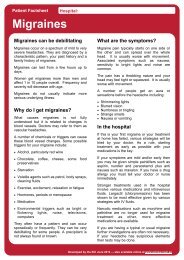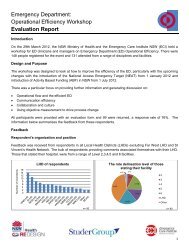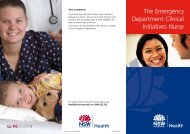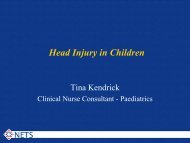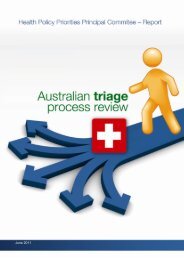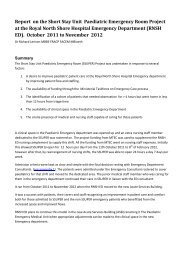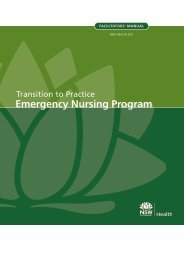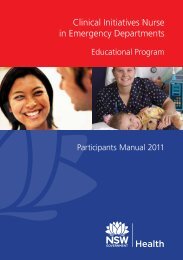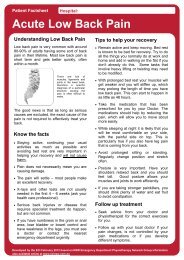Emergency Department Models of Care 2012 - NSW Health
Emergency Department Models of Care 2012 - NSW Health
Emergency Department Models of Care 2012 - NSW Health
- No tags were found...
You also want an ePaper? Increase the reach of your titles
YUMPU automatically turns print PDFs into web optimized ePapers that Google loves.
Benefits <strong>of</strong> the model ■ The triage process is streamlined by allowing the triage nurse to focus on assessment <strong>of</strong>acuity while the CIN monitors the waiting room■■■■Improved safety in the waiting room by monitoring patients to detect changes in clinicalurgency and escalating care if neededReduced anxiety and aggression in the waiting room by communicating waiting statusand ED processes to patients and familyAbility to commence early diagnostics services or treatmentImproved patient flow by referring patients to other MOCs.Challenges ■ During times <strong>of</strong> peak activity, the CIN becomes a second triage nurse, covers meal breaks<strong>of</strong> other ED staff or is utilised as an ‘extra’ nursing staff member within the ED — thisleaves waiting room patients unattended.■■Triage staff may become complacent about sending patients to the waiting room as theyknow the CIN will be monitoring the waiting room.Medical staff waiting to attend patients until after the CIN nurse has carried outdiagnostics testing, or being delayed in assessing patient by CIN assessment process.Case for implementationWhat you need to runthe modelTo assess the need for implementation or the refinement <strong>of</strong> this model in your ED, considerthe following:■■■Does your ED have significant capacity challenges requiring clinical queue management inthe waiting room?Does your ED have an appropriate system for monitoring the waiting room?Does your ED have established communication processes for patients in the waitingroom?■ How is your ED performing in triage to treatment times (especially in category 4–5)?■■■Staff■■■What is the percentage <strong>of</strong> patients in your ED who did not wait?Has your ED experienced adverse events and incidents for patients in the waiting room?Are there multiple complaints from patients and family in the waiting room?A Registered Nurse with appropriate emergency nursing experience across a broad range<strong>of</strong> ED rolesThe completion <strong>of</strong> the CIN educational program and competency in the use <strong>of</strong> relevantCIN practice protocolsRecognition by the organisation <strong>of</strong> the CIN role as a dedicated resource, not to beimplemented on an ad-hoc basis or regularly removed during peak activity or to coverunplanned leave or other vacancies.Skills required by staff■Confidence, knowledge and experience to practise proactively in a self-directed role withawareness <strong>of</strong> the role scope and boundaries, whilst maintaining good communicationwith other ED team members. This requires a balance <strong>of</strong> judgment and the assertivenessto seek assistance when requiredPAGE 16 <strong>NSW</strong> HEALTH <strong>Models</strong> <strong>of</strong> <strong>Emergency</strong> <strong>Care</strong>




